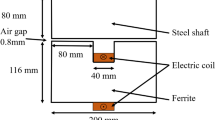Abstract
Journal bearings with magnetorheological fluids as tribotronic devices allow to adapt the parameters of the rotor-support system to changing operating modes. Multiple nonlinearities make them relatively complex objects for control. It is also necessary to take into account a number of restrictions at once, e.g., on the control action, friction, vibration amplitude. Such cases usually require applying advanced control techniques, such as based on machine learning methods. A controller based on deep Q-learning networks (DQN) was designed and tested for solving the task of reducing vibration and friction in the considered magnetorheological journal bearing. A nonlinear dynamic model of the rotor on such bearings was developed and validated by experimental study to implement the DQN controller. The bearing model is based on the magnetohydrodynamics equations and allows determining its dynamic parameters using the Multi-Objective Genetic Algorithm. The linearized dynamic bearing model takes into account the variability of the rotational speed and the control electromagnetic field. The learning process of the DQN agent was carried out with the establishment of a threshold on the vibration amplitude, which corresponds to the passing the resonant frequency of the rotor-bearing system. Testing the trained controller on the simulation model showed a decrease in the maximum amplitude by 15% in absolute values of vibration displacements, and by 32% in the time-averaged values comparing to a passive system. Also, the control current was not applied to the bearing outside the resonance zone, without increasing the coefficient of friction.
Access this chapter
Tax calculation will be finalised at checkout
Purchases are for personal use only
Similar content being viewed by others


References
Asadi Varnusfaderani, M., Irannejad Parizi, M., Hemmatian, M., Ohadi, A.: Experimental parameters identification of a flexible rotor system equipped with smart magnetorheological bearing. Mechatronics 87, 102880 (2022)
Quinci, F., Litwin, W., Wodtke, M., Nieuwendijk, R.: A comparative performance assessment of a hydrodynamic journal bearing lubricated with oil and magnetorheological fluid. Tribol. Int. 162, 107143 (2021)
Bompos, D., Nikolakopoulos, P.: Journal bearing stiffness and damping coefficients using nanomagnetorheological fluids and stability analysis. J. Tribol. 136, 041704 (2014)
Lampaert, S.G., Quinci, F., van Ostayen, R.A.: Rheological texture in a journal bearing with magnetorheological fluids. J. Magn. Magn. Mater. 4(499), 166218 (2020)
Horak, W., Szczech, M.: The analysis of the working conditions of a thrust squeeze bearing with a magnetorheological fluid operating in the oscillatory compression mode. Tribologia 285, 45–50 (2019)
Osman, T., Nada, G., Safar, Z.: Effect of using current-carrying-wire models in the design of hydrodynamic journal bearings lubricated with ferrofluid. Tribol. Lett. 11, 61–70 (2001)
Hesselbach, J., Abel-Keilhack, C.: Active hydrostatic bearing with magnetorheological fluid. J. Appl. Phys. 93, 8441–8443 (2003)
Urreta, H., Aguirre, G., Kuzhir, P., de Lacalle, L.N.L.: Actively lubricated hybrid journal bearings based on magnetic fluids for high-precision spindles of machine tools. J. Intell. Mater. Syst. Struct. 30, 2257–2271 (2019)
Zapomel, J., Ferfecki, P.: A new concept of a hydrodynamic bearing lubricated by composite magnetic fluid for controlling the bearing load capacity. Mech. Syst. Signal Process. 168, 108678 (2022)
Hamadache, M., Jung, J.H., Park, J., Youn, B.D.: A comprehensive review of artificial intelligence-based approaches for rolling element bearing phm: shallow and deep learning. JMST Adv. 1, 1–27 (2019)
Chen, H.Y., Lee, C.H.: Vibration signals analysis by explainable artificial intelligence (xai) approach: application on bearing faults diagnosis. IEEE Access 8, 134246–134256 (2020)
Pandarakone, S.E., Mizuno, Y., Nakamura, H.: A comparative study between machine learning algorithm and artificial intelligence neural network in detecting minor bearing fault of induction motors. Energies 12, 2105 (2019)
Ashraf, W.M., et al.: Artificial intelligence based operational strategy development and implementation for vibration reduction of a supercritical steam turbine shaft bearing. Alexandria Eng. J. 3(61), 1864–1880 (2022)
Chasalevris, A., Dohnal, F.: Modal interaction and vibration suppression in industrial turbines using adjustable journal bearings. J. Phys.: Conf. Ser. 744, 012156 (2016)
Di, L., Lin, Z.: Control of a flexible rotor active magnetic bearing test rig: a characteristic model based all-coefficient adaptive control approach. Control Theory Technol. 12(1), 1–12 (2014). https://doi.org/10.1007/s11768-014-0184-0
Davidson, P.A., Thess, A. (eds.): ICMS, vol. 418. Springer, Vienna (2002). https://doi.org/10.1007/978-3-7091-2546-5
Naife, A.: Introduction to Perturbation Methods, 2nd edn. Mir (1984)
Cherny, S.G., Chirkov, D.V., Lapin, V.N., et al.: Numerical Modeling of Flows in Turbomachines. Nauka, Novosibirsk (2006)
Fetisov, A.S., Kazakov, Y., Tokmakov, N.V.: Rotor trajectories on magnetorheological fluid-film bearings. Fund. Appl. Prob. Eng. Technol. 6(350), 76–82 (2021)
Fetisov, A., Kornaev, A.: Journal bearing with variable dynamic characteristics: simulation results and verification. Fund. Appl. Prob. Eng. Technol. 2(346), 140–145 (2021)
Mnih, V., et al.: Playing atari with deep reinforcement learning, pp. 1–9 (2013)
Acknowledgment
The study was supported by the Russian Science Foundation grant No. 22–19-00789, https://rscf.ru/en/project/22-19-00789/.
Author information
Authors and Affiliations
Corresponding author
Editor information
Editors and Affiliations
Rights and permissions
Copyright information
© 2023 The Author(s), under exclusive license to Springer Nature Switzerland AG
About this paper
Cite this paper
Fetisov, A., Kazakov, Y., Savin, L., Shutin, D. (2023). Synthesis of a DQN-Based Controller for Improving Performance of Rotor System with Tribotronic Magnetorheological Bearing. In: Abraham, A., Pllana, S., Casalino, G., Ma, K., Bajaj, A. (eds) Intelligent Systems Design and Applications. ISDA 2022. Lecture Notes in Networks and Systems, vol 717. Springer, Cham. https://doi.org/10.1007/978-3-031-35510-3_9
Download citation
DOI: https://doi.org/10.1007/978-3-031-35510-3_9
Published:
Publisher Name: Springer, Cham
Print ISBN: 978-3-031-35509-7
Online ISBN: 978-3-031-35510-3
eBook Packages: Intelligent Technologies and RoboticsIntelligent Technologies and Robotics (R0)


